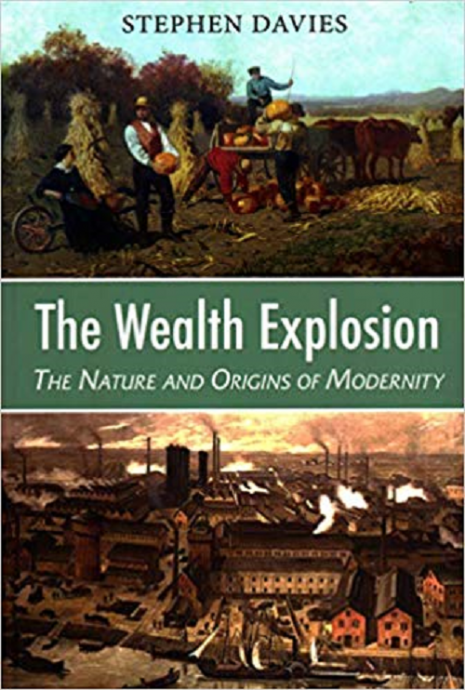Our novelists, from Austen to Christie, spy hints of trouble lurking beneath the placid surface of civilized life.
Advent of the Modern Economy: A Panoramic View
What is modern economic growth, and why was it invented in the West? These questions have preoccupied historians for a long time. They typically focus on one, big explanation, going for an all-encompassing cause. This makes for good debates but not necessarily for good history.
In The Wealth Explosion: The Nature and Origins of Modernity, Stephen Davies takes a different course. Davies, Head of Education at London’s Institute of Economic Affairs, allows readers to develop a panoramic view. This is fitting, as there really aren’t simple answers to the question of where modern economic growth comes from.
Davies considers modernity as one of the great fractures in human history, comparable to the transition from the Palaeolithic to the Neolithic Age, when man first domesticated animals and started to trade, and to the advent of agriculture. Modernity brought fundamental changes in human life, which percolated in every aspect of society. When Reverend Thomas Malthus published his Essay on Population in 1798, the observable reality was that “all human beings, even many of the wealthy, were always living on the edge of dearth and famine.” Sure enough, Malthus “proved to be one of the worst prophets ever,” writes Davies, “given the way things have worked out from his time to our own,” but he described well the world he knew. Resource constraints made human civilization seem a rather precarious thing.
Malthus Versus Simon
If we now think civilization stands on firmer ground, it is precisely because innovation has unleashed unprecedented growth. In a world that keeps breaking the chains of scarcity, “a growing population is not the inevitable premise of mass starvation. But, on the contrary, hands and heads that can further contribute to creating prosperity and wealth.” Two centuries after Malthus, economist Julian Simon could label human beings themselves as “the ultimate resources.” We all know that each of us is at the same time a resource and a constraint for others, if only for elbow room. How much of a resource and how much of constraint largely depends on our circumstances. In a world of economic growth and open-ended innovation, Simon, not Malthus, proved to be right.
This is the gist of modern economic growth: something that not only provides more, but does so for more people. As Davies reminds us,
After slightly more than a century of steady growth total world population reached one billion around 1830. It then doubled to two billion by 1930 and then doubled again by 1975 … not only is the world’s population much larger now than at any time in the past but the rate at which population has increased has accelerated dramatically.
Just think about our own lifetime. Although in 1990, two billion people were living on less than two dollars a day all over the world, in 2015, 705 million people were doing so. In those 25 years, the world population rose from 5.3 billion to some seven billion.
Yet modernity is not exclusively modern economic growth, but rather all that surrounds (and perhaps enables) that growth. Intensive economic growth is a necessary component of this multifaceted phenomenon, but so are population growth, urbanization, and rapid and sustained technological change. Nor does economic change happen in a vacuum: Secularism and a more individualistic way of living are part of modernity, as are the development of “critical rationalism,” the abolition of slavery, and the extension of sympathetic relations well beyond the family sphere.
In this work, Davies avoids normative speculation. He doesn’t consider whether a more traditional or religious approach to life can be fully compatible with industrialization and modern economic growth, a matter dear to the hearts of conservatives of all latitudes. His ambition is to make sense of those big trends that, put together, give us an idea of what modernity is. The fact that religion no longer occupies center stage in human life, and underwent a divorce from modern political power, is certainly one such trend. For Davies modernity is thus made of mutually dependent parts, each of which could perhaps exist on its own, but all of which have somehow paved the way for the others.
Exceptionalism Contested
For all who know him, Steve Davies is a more accurate surrogate of Wikipedia. A photographic memory and the closest approximation of omniscience ever displayed by a human being are the distinctive traits of this St. Andrews University-educated historian. Davies’s passionate erudition comes through in every chapter of the book, which carefully presents competing theses on why modernity first happened here—“here” meaning Europe, and more precisely, Northern Europe, and even more precisely the Dutch Republic and the United Kingdom. This book will prove invaluable to the student seeking a gateway to a complex historical debate. But it will also be extremely helpful to the more experienced reader, for whom it will be a true compass to navigate the intricacies of historical interpretation.
For Davies, there was nothing inevitable about modernity nor about the Industrial Revolution. Modern economic growth could have developed somewhere else and at some other time—say, in China under the Song dynasty (960–1279). Yet that road was not taken, and that made all the difference. How come? Some historians—David Landes is cited in this connection—have put forth “Western exceptionalism” as the driver of modern progress. Others have rejected this hypothesis, arguing that Europe’s recent rise to prominence is due to its predatory policies, which drained resources from the rest of the world. Davies is most at home with those who “accept that there was nothing distinctive about Europe for most of the world’s history . . . but . . . argue that something happened within Europe not too long before the transformation’s commencement.”
So the challenge of explaining modernity becomes the challenge of identifying those sea changes and smaller transformations that eventually brought the greater ones. Though Davies modestly states that his is not “a work of original research,” but rather of synthesis, this viewpoint is distinctive.
For one thing, he stresses the importance of “critical rationalism” in modernity, by which he means the fashioning of alternatives to the two streams of “systematic thought” that dominated human experience: magic and religion. Both rely on authority and tradition, assuming that a large body of knowledge “that describes all that can be known about everything” exists, and needs at best to be discovered and interpreted. Modernity is shaped by a way of thinking that believes that the world can be known, and moderns labor to find ways to test the relative accuracy of different conjectures on its nature. The very phrase “critical rationalism” reminds us of Karl Popper and his emphasis on knowledge being open to criticism and, indeed, to being proved false. Settled disputes were no longer settled forever, and evidence emerged as the yardstick to evaluate statements about the truth. Such an appreciation of the value of trial-and-error processes came with a favorable attitude toward keeping the door open to novelty and surprise. This is indeed something distinctive about modernity—and, in particular, of the modern economy.
The Passage to a Post-Malthusian World
The notion that modernity and rationalism go hand in hand is hardly surprising. Yet Davies adds a peculiar dimension, focusing on how the spread of the scientific method, innovation, and modern ideas influenced the actions of rulers. While he understands modernity as something that reshaped the whole of society, including the lower rungs of the social ladder.
A good chunk of The Wealth Explosion is concerned with politics. The author reads political history not only as a succession of powerful men on the top (though the Emperor Taizu of Song, Tamerlan, and Charles V all play roles in his story), but as a Meccano of institutions and power relationships.
One feature of modernity that is notably absent from most of the human societies before the Industrial Revolution (with, again, the exception of Song China), was the tendency to embrace experimentation and novelties rather than opposing them. Another is a positive attitude on the part of the rulers toward economic improvement, which they embraced as a way to enfranchise their fellow citizens rather than fearing it as a source of social disarray.
It takes a post-Malthusian world to even think that the pie can be expanding for all. This has to do with the emergence of critical rationalism and the successes of modern science, but also the persistent pluralism (political and, after the Reformation, religious) of the European Continent. The “great consequence” of this pluralism “was that the ruling classes in Europe faced quite different incentives as compared to their counterpart in Asia. They were now part of a system of constant and intense competition.” This pluralism was strengthened, Davies argues, in the late 16th and the early 17th centuries as Habsburg Spain failed to become a hegemonic power in Europe.
Some of the competition was military and destructive, but some was not. Consider David Hume’s wisdom: “Nothing is more favourable to the rise of politeness and learning, than a number of neighbouring and independent states, connected together by commerce and policy.” Competition in commerce in fact means being part of a joint enterprise, in learning and experimentation. The rivalry between administrations and jurisdictions can stifle this process—but it can encourage it, too, as happened with monarchies bidding for the better artists and, later, for the better scientists.
An economy that fosters innovation depends on social and political innovation. This might be a sobering thought. In describing China under the Song Dynasty, Davies explains that it moved further from subsistence and closer to a modern market economy than any other regime of its time. Government controls were weakened, the production of most goods was “commodified”—that is, it went beyond the boundaries of a family-oriented, subsistence economy to become a matter of trade—and its government structure became leaner and more meritocratic. “The interesting thing is that the response of the elite was to go along with this process rather than to resist it or try to reverse it,” Davies writes.
Yet modern economic growth didn’t blossom in Song China, where actually the Ming Dynasty planned and achieved an anti-modern revolution, reestablishing traditional values to exert tighter control of the population. Political innovation didn’t happen in Asia back then. Part of what defines modernity is a growing reliance on the state. What happens if we rely on the government to do away with the other pieces of modern science, be they competition or critical rationalism? The wise think that freedom is never more than one generation away from extinction. They should also realize that the economy is never more than one generation away from decline—and they should act accordingly.



